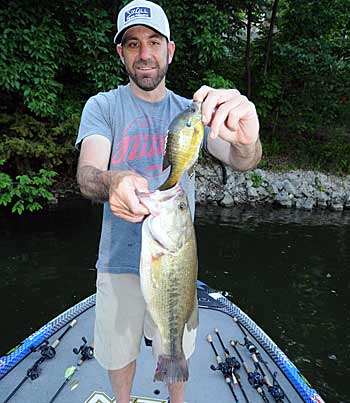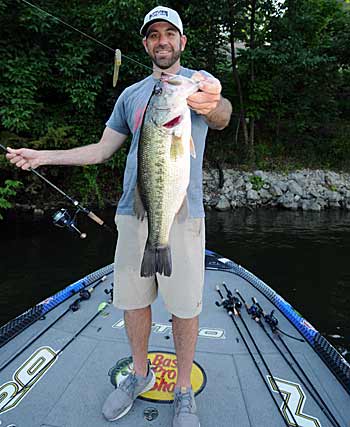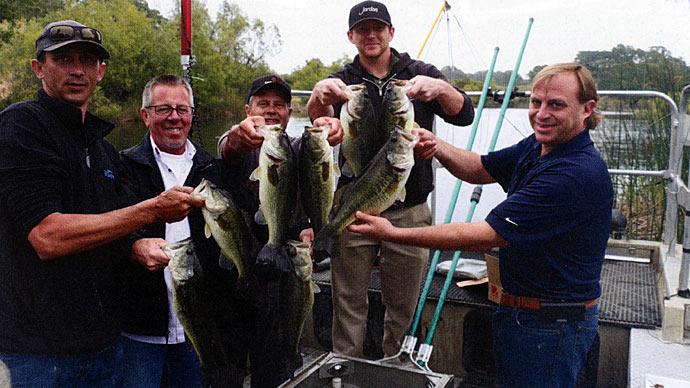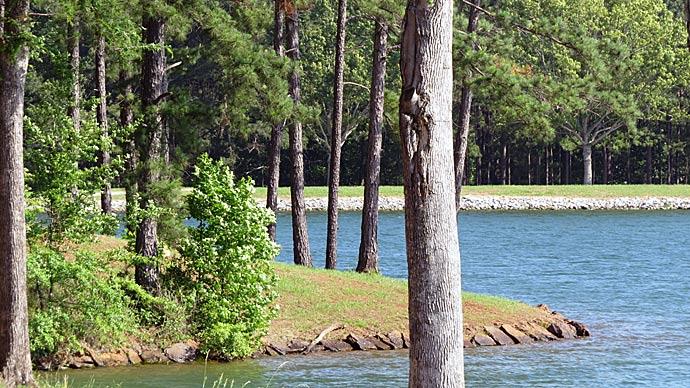
Searching the shallows of your favorite lake for a crater-filled bottom looking like the moon’s surface will help you find bass this summer.
Those crater-filled bottoms indicate bluegill are spawning, and it’s revenge time for bass that have just finished spawning. Throughout the bass spawn, nesting bass are constantly chasing bluegill away from their nests. Bass have a chance to get even during the bluegill spawn by harassing the bedding sunfish and picking off any spawners that venture too far from their nests.
The bluegill spawn thus becomes a prime time to catch shallow bass throughout the summer and early fall. “The bluegill spawn follows the bass spawn, and the bass are hungry and aggressive and are already up shallow from spawning,” Tackle Warehouse Pro Circuit competitor Casey Scanlon says. “So bluegill are a good easy meal for them. The bluegill group up in big colonies so the bass can remain shallow, pick off an easy meal, and gain some weight for the summer.”
Typical bluegill spawning areas are usually flat pea gravel or sandy pockets in the backs of creeks or bays. Scanlon hunts for bluegill beds on his home waters of Lake of the Ozarks in the same areas he usually targets for spawning bass. “It’s like sight fishing for bass,” he says. “You put the trolling motor down and look for the beds. When you find the beds, it looks like a bunch of craters on the bottom.”
Scanlon notices bluegill usually start spawning around a full moon when the water temperature reaches the 70-degree mark. Bluegill are prolific breeders that spawn in some areas of the country throughout the summer and into early fall. Bass in those areas will attack nesting bluegill throughout the summer. “There will be a lot of bass up there shallow in what we call wolf packs to where there will be two or three bass or up to a dozen bass that just cruise the banks looking for the bluegill,” Scanlon says.
“The bass are usually around the perimeters of the bluegill beds,” Scanlon says. “Sometimes you can see them, but a lot of times they are kind of lurking in the shadows just outside of the bluegill beds.”
Scanlon often casts his lures outside the bluegill beds to any nearby cover, such as boat docks or logs. If he can see bluegill beds 2 to 3 feet deep, Scanlon will cast into depths of 4 to 5 feet for bass lurking just out of sight. The Missouri pro will cast directly into the bluegill colonies if he sees bass running through the spawning beds.
The size of bass lurking around bluegill beds ranges from average-size keepers to 4- or 5-pounders or even larger depending on whatever size bass the lake is capable of producing. “Bluegill are a pretty big meal so that those big bass will hunt them down,” Scanlon says.
The Lake of the Ozarks guide catches bass stalking nesting bluegill with four lures: a 3/8-ounce Trophy Bass Company Pro Jig tipped with a plastic craw, wacky-rigged Tackle HD Stix Worm, Tackle HD Worldwide Buzzer buzzbait, and a Rebel Pop-R.

Scanlon pitches the jig around any cover close to the bluegill beds. For his jig and trailer, he chooses colors resembling bluegill, such as green pumpkin. The touring pro experiments with his jig retrieve until he catches a fish. “Typically, I am just hopping it off the bottom and crawling it around any visible cover I can find,” he says.
The Stix Worm wacky-rigged with a 1/0 Hayabusa trailer hook is Scanlon’s choice when he sees bass cruising around the bluegill beds. “It’s a soft stickbait that is subtle and slow falling and produces a lot of bites when you slow down and find the beds,” says Scanlon, who also pitches the lure to shallow cover near the beds. “I am letting it sink down slowly and inching it along the cover. A lot of bites come on the fall.” Scanlon selects Stix Worms in green or watermelon hues and dips the tails in chartreuse dye to mimic a bluegill.
Scanlon uses the Tackle HD Worldwide Buzzer to cover water quickly around bluegill spawning areas. He opts for a black or white buzzbait and adds a plastic toad body to the lure. Retrieving the buzzbait at a medium steady pace allows Scanlon to keep the buzzbait churning along the surface. He adds action to the lure by occasionally popping it to trigger more strikes from bass hanging around the bluegill beds.
The Rebel Pop-R is Scanlon’s choice for keeping a topwater bait close to the bluegill beds as long as possible. Scanlon tries slightly walking the Pop-R to keep it in place, then gives it a few short pops and lets it sit for a couple of seconds.
Fishing around shallow bluegill beds requires some stealth to prevent spooking bass waiting to ambush any bluegill that stray too far from their beds. “Any time you’re fishing shallow, being stealthy is a real key,” Scanlon says. He relies on his Garmin Force trolling motor turned to a low setting to move around in the shallows quietly and drops his Power Poles if he finds a large colony of bedding bluegill. Other stealthy measures he employs to prevent spooking shallow bass include turning off his transducers for his console electronics, walking softly on his boat’s deck, closing storage lids quietly, and positioning his boat to prevent casting his shadow on the bluegill beds or any nearby casting targets.




